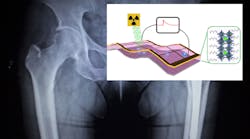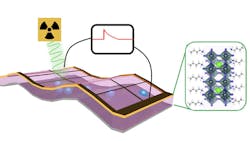A new X-ray detector prototype could dramatically reduce the radiation exposure and its associated health risks for healthcare workers and patients, at the same time boosting the resolution of medical X-rays, security scanners and research devices. It was developed by a team of researchers from Los Alamos and Argonne National Laboratories.
The new detector used a structure built around a thin film of the mineral perovskite rather than the traditional silicon-based technology. (Perovskite is a calcium titanium oxide mineral composed of calcium titanate, CaTiO3. The term also refers to the class of compounds with the same type of crystal structure as CaTiO3.) The detector is 100 times more sensitive than conventional ones and does not need an outside power source to generate electrical signals in response to X-rays. This could open the door to battery-powered X-ray machines with much more portability than today’s versions.
“The perovskite material at the heart of our detector prototype can be produced with low-cost fabrication techniques,” said Hsinhan (Dave) Tsai, an Oppenheimer Postdoctoral fellow at Los Alamos National Laboratory. “The result is a cost-effective, highly sensitive and self-powered detector that could radically improve existing X-ray detectors, and potentially lead to a host of unforeseen applications.”
For example, the highly sensitive detectors could lead to medical and dental images that require a tiny fraction of the radiation exposure that accompanies conventional X-ray images. Perovskite detectors are thinner, which lets gives them better resolution for highly detailed images. Clearer images, in turn, could lead to more accurate medical evaluations and diagnoses.
Perovskite is rich in heavy elements, such as lead and iodine, so X-rays that easily pass through silicon undetected are more readily absorbed and detected in perovskite. As a result, perovskite significantly outperforms silicon, particularly at detecting high-energy X-rays. This would be a crucial advantage in monitoring X-rays at high-energy research facilities, such as synchrotron light sources.
Perovskite films are usually deposited on surfaces by spraying solutions that cure and leave behind thin layers of the material. As a result, thin-layer detectors will be much easier and less expensive to manufacture. Silicon-based detectors, on the other hand, are made using high-temperature metal deposition under vacuum conditions.
“Potentially, we could use versions of ink jets to print large scale detectors,” says Tsai. “This would let us replace half-million-dollar silicon detector arrays with inexpensive, higher-resolution perovskite alternatives.”
In addition to the promise of thin-layer perovskites in X-ray detectors, thicker layers also work well, provided they include a small voltage source. This suggests that their useful energy range could be extended beyond X-rays to low-energy gamma-rays.

